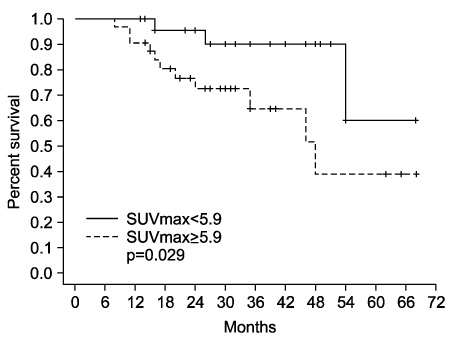Tuberc Respir Dis.
2011 Dec;71(6):425-430.
Prognostic Value of Preoperative Positron Emission Tomography-Computed Tomography in Surgically Resected Stage I and II Non-Small Cell Lung Cancer
- Affiliations
-
- 1Division of Pulmonology, Cheju Halla General Hospital, Jeju, Korea.
- 2Department of Internal Medicine, Hanyang University College of Medicine, Guri, Korea. jwsohn@hanyang.ac.kr
- 3Department of Nuclear Medicine, Hanyang University College of Medicine, Guri, Korea.
Abstract
- BACKGROUND
High 2-[18F] fluoro-2-deoxy-D-glucose (FDG) uptake on positron emission tomography-computed tomography (PET-CT) is a prognostic factor for poor survival in non-small cell lung cancer (NSCLC), especially in Stage I. We determined whether the high FDG uptake value of a primary tumor was associated with recurrence and death in patients with resected Stage I and Stage II NSCLC.
METHODS
We identified consecutive patients who underwent complete surgical resection for Stage I and II NSCLC between 2006 and 2009, who had preoperative PET-CT, and reviewed clinical records retrospectively. FDG uptake was measured as the maximal standardized uptake value (SUVmax) for body weight. Patients were divided into two groups based on SUVmax: (i) above or (ii) below the cut-off value (SUVmax=5.9) determined by a receiver operating characteristic (ROC) curve.
RESULTS
Of 57 patients who were enrolled consecutively, 32 (56%) had Stage I NSCLC and 25 (44%) had Stage II. The 5-year recurrence-free survival (RFS) for patients with high (> or =5.9) and low (<5.9) SUVmax were 31% and 57%, respectively (p=0.014). The 5-year overall survival (OS) rates were 39% and 60%, respectively (p=0.029). In univariate analyses, SUVmax (p=0.014), T staging (p=0.025), and differentiation of tumor tissue (p=0.034) were significantly associated with RFS. But, multivariate analyses did not show that SUVmax was an independently significant factor for RFS (p=0.180).
CONCLUSION
High FDG uptake on PET-CT is not an independent prognostic factor for poor outcomes (disease recurrence in patients with resected Stage I and II NSCLC).
MeSH Terms
Figure
Reference
-
1. Korean National Statistical Office. The cause of death statictics. 2008. Daejeon: Korean National Statistical Office.2. Kim YC, Kwon YS, Oh IJ, Kim KS, Kim SY, Ryu JS, et al. National survey of lung cancer in Korea, 2005. J Lung Cancer. 2007. 6:67–73.3. Goldstraw P, Crowley J, Chansky K, Giroux DJ, Groome PA, Rami-Porta R, et al. The IASLC Lung Cancer Staging Project: proposals for the revision of the TNM stage groupings in the forthcoming (seventh) edition of the TNM Classification of malignant tumours. J Thorac Oncol. 2007. 2:706–714.4. Asamura H, Goya T, Koshiishi Y, Sohara Y, Eguchi K, Mori M, et al. A Japanese Lung Cancer Registry study: prognosis of 13,010 resected lung cancers. J Thorac Oncol. 2008. 3:46–52.5. Goodgame B, Pillot GA, Yang Z, Shriki J, Meyers BF, Zoole J, et al. Prognostic value of preoperative positron emission tomography in resected stage I non-small cell lung cancer. J Thorac Oncol. 2008. 3:130–134.6. Higashi K, Ueda Y, Arisaka Y, Sakuma T, Nambu Y, Oguchi M, et al. 18F-FDG uptake as a biologic prognostic factor for recurrence in patients with surgically resected non-small cell lung cancer. J Nucl Med. 2002. 43:39–45.7. Kim HR, Kim DJ, Lee WW, Jheon S, Sung SW. The significance of maximum standardized uptake values in patients with stage I pulmonary adenocarcinoma. Eur J Cardiothorac Surg. 2009. 35:712–716.8. Um SW, Kim H, Koh WJ, Suh GY, Chung MP, Kwon OJ, et al. Prognostic value of 18F-FDG uptake on positron emission tomography in patients with pathologic stage I non-small cell lung cancer. J Thorac Oncol. 2009. 4:1331–1336.9. Cho S, Lee EB. A follow-up of integrated positron emission tomography/computed tomography after curative resection of non-small-cell lung cancer in asymptomatic patients. J Thorac Cardiovasc Surg. 2010. 139:1447–1451.10. Berghmans T, Dusart M, Paesmans M, Hossein-Foucher C, Buvat I, Castaigne C, et al. Primary tumor standardized uptake value (SUVmax) measured on fluorodeoxyglucose positron emission tomography (FDG-PET) is of prognostic value for survival in non-small cell lung cancer (NSCLC): a systematic review and meta-analysis (MA) by the European Lung Cancer Working Party for the IASLC Lung Cancer Staging Project. J Thorac Oncol. 2008. 3:6–12.11. Nair VS, Krupitskaya Y, Gould MK. Positron emission tomography 18F-fluorodeoxyglucose uptake and prognosis in patients with surgically treated, stage I non-small cell lung cancer: a systematic review. J Thorac Oncol. 2009. 4:1473–1479.12. Sasaki R, Komaki R, Macapinlac H, Erasmus J, Allen P, Forster K, et al. [18F]fluorodeoxyglucose uptake by positron emission tomography predicts outcome of non-small-cell lung cancer. J Clin Oncol. 2005. 23:1136–1143.13. de Jong WK, van der Heijden HF, Pruim J, Dalesio O, Oyen WJ, Groen HJ. Prognostic value of different metabolic measurements with fluorine-18 fluorodeoxyglucose positron emission tomography in resectable non-small cell lung cancer: a two-center study. J Thorac Oncol. 2007. 2:1007–1012.
- Full Text Links
- Actions
-
Cited
- CITED
-
- Close
- Share
- Similar articles
-
- 18F-2-Deoxy-2-Fluoro-D-Glucose Positron Emission Tomography: Computed Tomography for Preoperative Staging in Gastric Cancer Patients
- Prognostic Usefulness of Maximum Standardized Uptake Value on FDG-PET in Surgically Resected Non-small-cell Lung Cancer
- Preoperative Risk Factors for Pathologic N2 Metastasis in Positron Emission Tomography-Computed Tomography–Diagnosed N0–1 Non-Small Cell Lung Cancer
- Positron Emission Tomography/Computed Tomography in the Staging of Colon Cancer
- Breast Metastatic Squamous Cell Carcinoma from Lung



